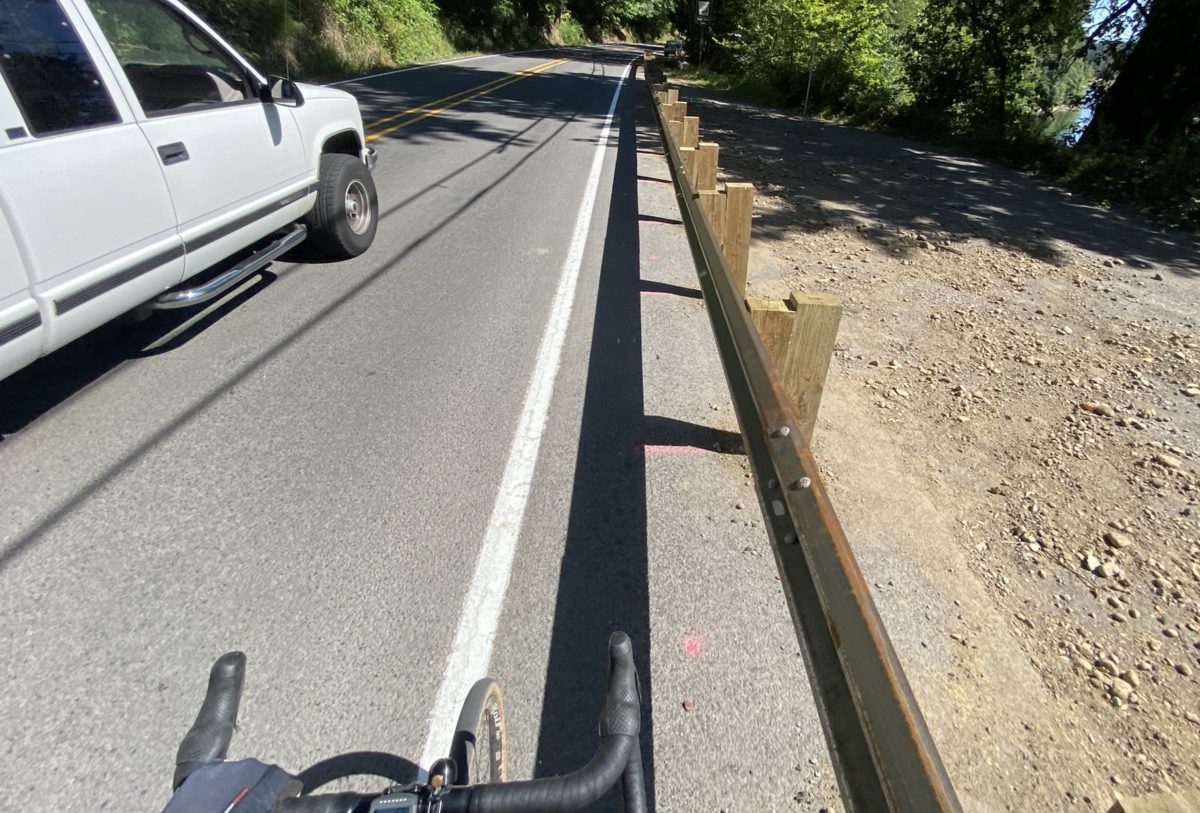
(Photo: J. Maus/BikePortland)
Late last month the Oregon Department of Transportation installed several thousand feet of guardrails in the paved shoulder of the Historic Columbia River Highway (U.S Route 30). The new rails, located just outside Troutdale along the Sandy River, were meant to keep people from parking and camping in undeveloped turnouts.
Unfortunately the rails had a significant and negative impact on bicycle users because they were installed too far into the shoulder. This route is an extremely popular and important part of many cycling routes. After we pointed this out, ODOT’s regional director Rian Windsheimer acknowledged that was the “wrong decision.” He said the rails were meant to be installed further away from the shoulder, but work crews realized there was a gas line underground and made a spur-of-the-moment decision to move the railing toward the travel lanes. Windsheimer also said two of the three sections of rails would be removed.
I was curious about how the removal work went and wanted to see which section of railings remained. So on Monday I rolled out for a test ride and a closer look. What I saw was disappointing: The remaining guardrails are still dangerous and the removed ones have left behind a pock-marked shoulder full of gravel.
Here are photos of the section that remains:
(Photos: J. Maus/BikePortland)
(Photo: J. Maus/BikePortland)
Windsheimer’s statement made it seem like he had ordered staff to rectify the situation. I assumed that meant the section left in the ground would be relatively innocuous; but I was wrong. The section that remains, just north of Tad’s Chicken ‘n Dumplings where the official Columbia River Gorge Scenic Byway begins, reduces the space for cycling and creates a hazard. The guardrail juts into the paved shoulder and it forced me to ride directly on the fog line instead of comfortably inside of it. The width of the remaining shoulder is only about three-feet wide for most of the 1,000-foot railing section. Add a shy distance (space needed to have breathing room away from the railing) and I was left with only 1-2 feet of usable space.
Advertisement
That width is substandard even by ODOT’s own published design guidelines. ODOT’s Bicycle & Pedestrian Design Guide (PDF) recommends a width of five or six feet. “Shoulders adjacent to a guardrail or other roadside barriers must be 5 feet wide, as cyclists will ‘shy’ away from a vertical face,” the guide states. A chart in the guide says rural arterials with over 400 cars per day should have shoulder widths of at least six feet.
As for the sections that have been removed, ODOT has not cleaned up after themselves very well. Dozens of holes where the guardrail posts once stood are now filled with gravel. The gravel is spread all over the shoulder and the holes have created bumps. These holes mean that bicycle riders have to choose between running over them (which could cause a crash) or riding to the left of them — which puts them right back near the fog line just like the guardrails themselves once did!
This entire episode is frustrating and should have never happened. I’m hopeful ODOT will return to do a better clean-up job and that they will remove the remaining section of guardrail. Stay tuned.
— Jonathan Maus: (503) 706-8804, @jonathan_maus on Twitter and jonathan@bikeportland.org
— Get our headlines delivered to your inbox.
— Support this independent community media outlet with a one-time contribution or monthly subscription.







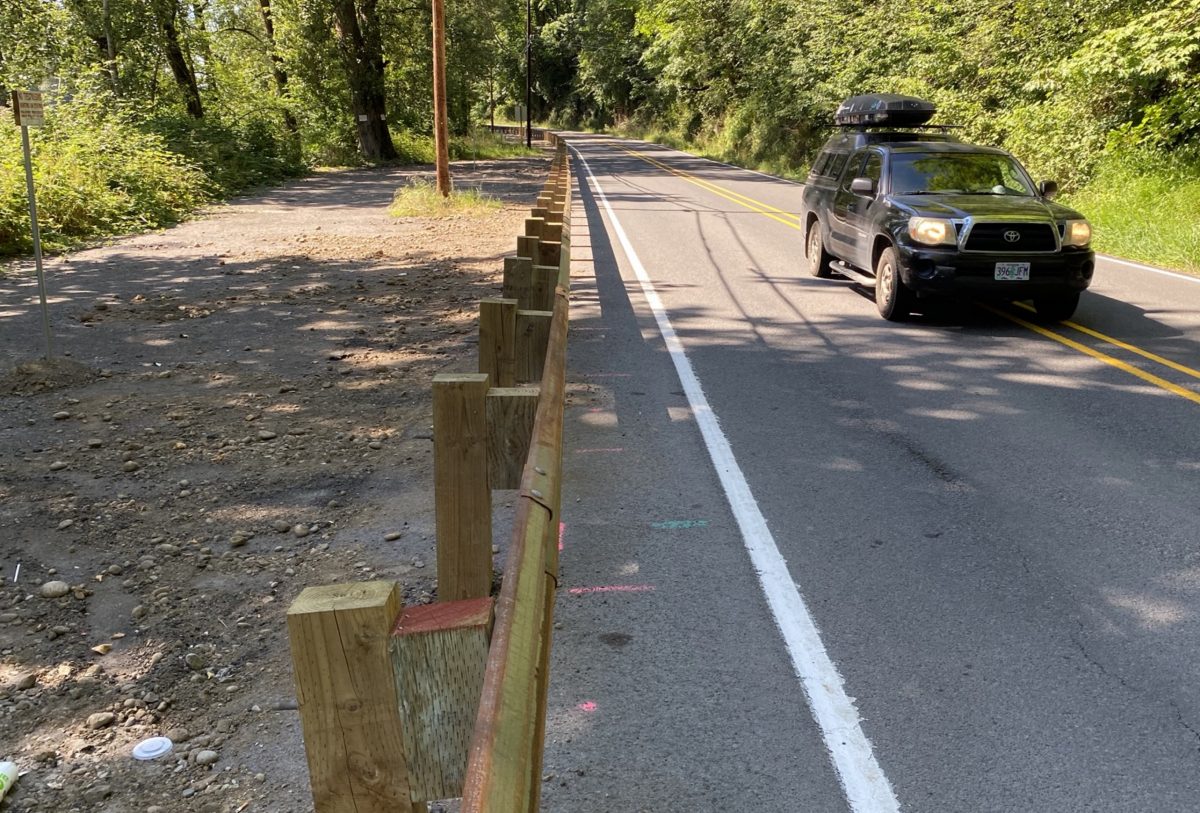

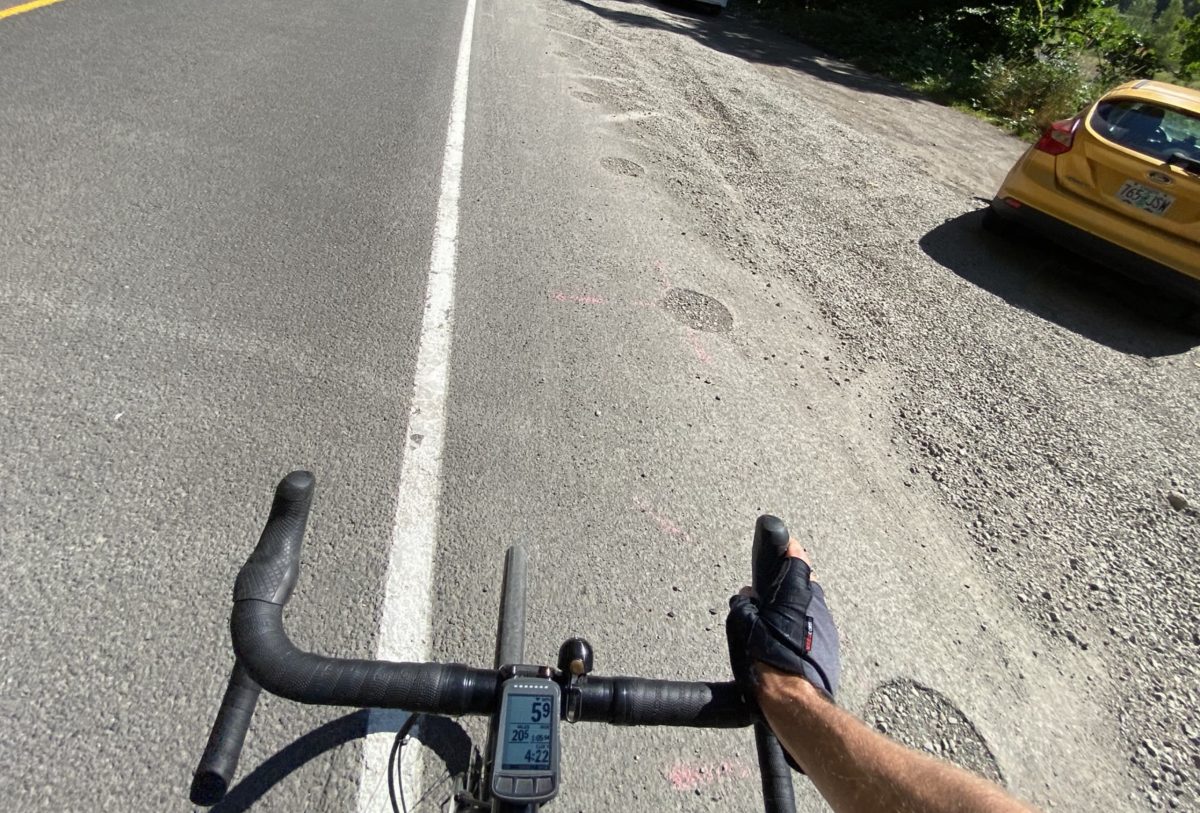
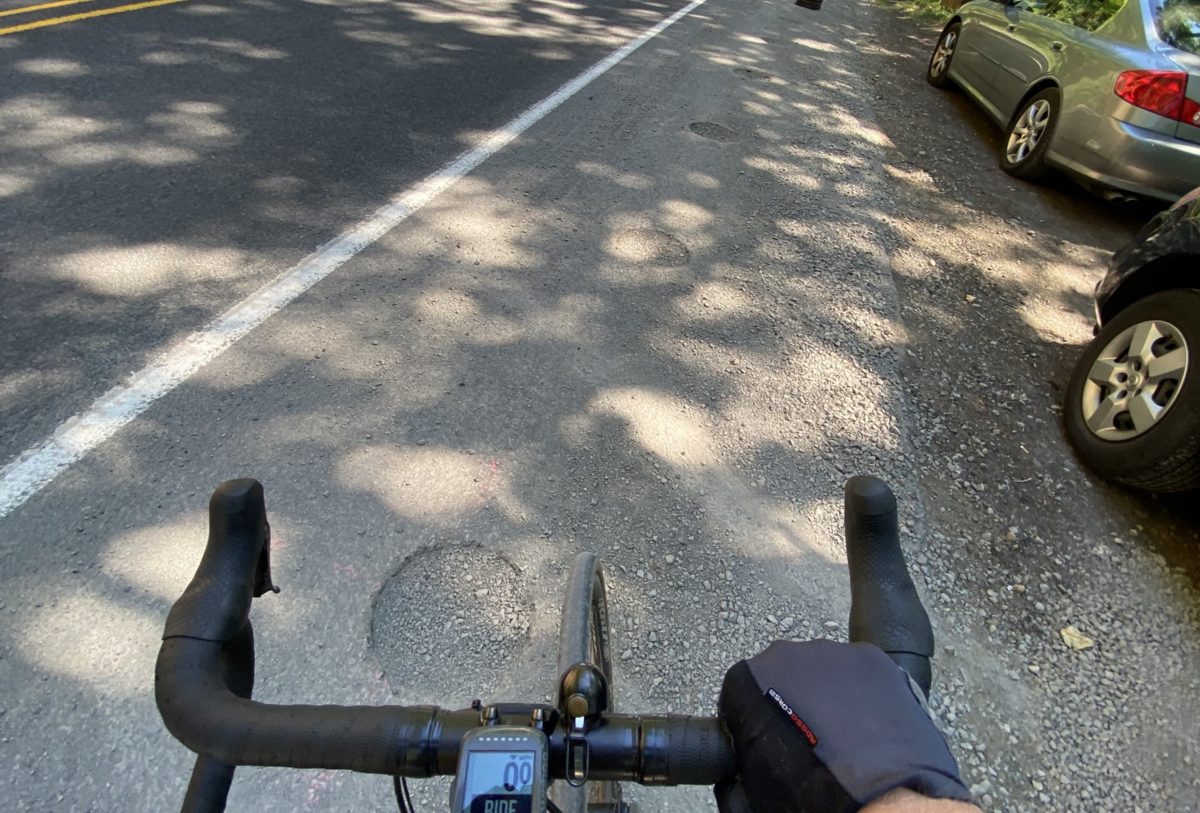
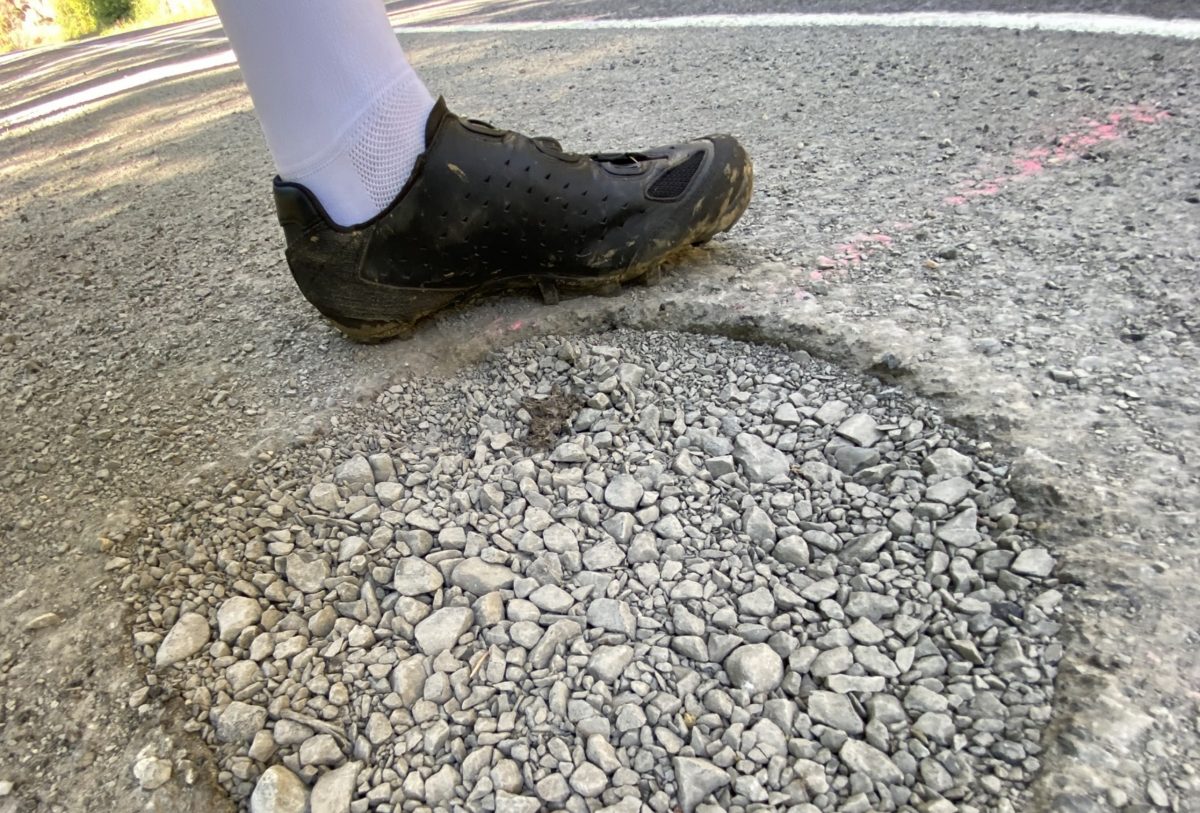
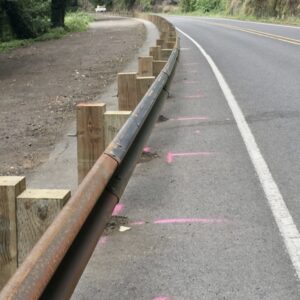
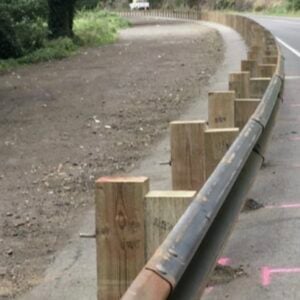
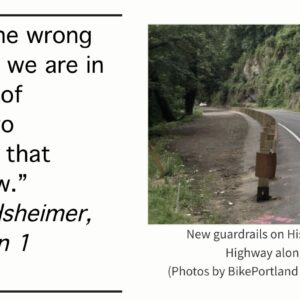

Thanks for reading.
BikePortland has served this community with independent community journalism since 2005. We rely on subscriptions from readers like you to survive. Your financial support is vital in keeping this valuable resource alive and well.
Please subscribe today to strengthen and expand our work.
Well, it seems like the first person to go to hospital because of ODOTs fabfricated potholes could at least sue them.
Does ODOT have anybody in their project management department that rides a bike? I am confronted by these kinds of design flaws all the time. Bike riders, along with pedestrians and other slower vehicle road users are continually treated as secondary users. I will not be engineered off the road until the citizenry chooses to prohibit my use of the roadway in question. In a situation such as Jonathan shows on the Columbia River Highway (CRH?), I simply ride out in the lane. Typically when a rider is away from a side barrier, they are easier to see by an oncoming motorist anyway.
Grrrr.
Aside from the fact that most construction workers would not be caught dead riding a *spits to side* bi-sickle anywhere other than an off road trail, most road construction projects take place during standard “9 to 5” weekday work hours. Because of this they usually see far fewer cyclists using public roads who have to leave earlier for work and/or get home later.
This is especially amplified in this case because of the recreational nature of the route. The workers may have never even seen a single bicycle on this stretch road because they were not there on a beautiful Saturday or Sunday when hundreds of people would be traveling through by bike.
The short answer is no. When I once asked for some simple pothole repair on the shoulder of an ODOT highway, the supervisor reported having to park his truck and walk up and down the shoulder to find the spot I was talking about. ODOT is simply unaware of the conditions of the cycling facilities they are responsible for maintaining, and it’s unacceptable. But they seem well aware of conditions in “the travel lane” (doesn’t that phrase tell you everything you need to know about their priorities?).
Ughh…
If only:
“Late last month the Oregon Department of Transportation installed several miles of bike paths along the shoulder of the Historic Columbia River Highway (U.S Route 30). The new bike paths, located just outside Troutdale along the Sandy River, are meant to keep people safe from traffic.
Fortunately the paths are having a significant and positive impact on bicycle users because this route is an extremely popular and important part of many cycling routes. After we pointed this out, ODOT’s regional director Rian Windsheimer acknowledged that was the “best decision he ever made and waaay better than that stupid guardrail idea someone tried to pull off.”
“I’m hopeful ODOT will return to do a better clean-up job and that they will remove the remaining section of guardrail.“
Unfortunately I don’t share your optimism. The should repaving fiasco on Hwy 101 back in 2013…
https://bikeportland.org/2013/08/28/odot-considers-repairs-caused-by-repaving-project-on-highway-101-93191
I was back this week (Oswald West area) walking along the shoulder for a few miles, and retook the photos I took back then.
It never got fixed(!) Since I don’t know how to post photos here I emailed you one.
Jeez. I can’t believe those shoulders still look like that. Maybe they did the same song-and-dance they did here. Fix SOME of it but not ALL of it. So tired of these games and having to fight our own state agency for basic respect and accommodation. Thanks for sharing 9watts. I’ll ask around.
Agreed.
Basic Respect.
If anyone had any lingering doubt about ODOT’s priorities, their attitude about or interest in people who bike, I think these examples which, let us note, are paid for with OUR tax dollars, should clarify the situation. Those shoulders on 101 are, still, *unridable*.
This “solution” to the problem created by the hazardous guardrails/barriers is just so depressingly on-brand for the age in which we are living. I find it helps my mental health to just always expect the worst and dumbest outcome in situations like this…makes the disappointment hurt less.
This new line of small potholes are arguably more dangerous than the guardrail they once contained, as they’re tough to see, and will not only spread gravel around as vehicles drive over them, but deepen and become more hazardous over time. I suppose it is possible that ODOT intends to come out and fill them with asphalt and make them smooth, and reinstall the guardrail farther back, but then again….that would make far too much sense.
It’s much harder to make a smooth level asphalt patch flush with the surrounding pavement, one that won’t sink in, then it is to lay down continuous pavement. I think it may be time to invest in some 700 x 38’s or possibly a tubeless wheelset, no extra bike tax! –because I don’t see ODOMV pulling this off with any grace. I’d rather support my LBS as opposed to waiting for a feckless bureaucracy to be dragged kicking and screaming across the Bridge to the 21st Century.
Self-edit further rant…going out to look for the comet “2 fists” below Ursa Major just after dark.
It is not only ‘harder’, it is impossible to make the repairs flush, for any length of time. This falls under the ‘be careful what you wish for’, Jonathan. Removal of the posts and repaving the shoulder would have cost probably ten’s of thousands of dollars, and left a directional ‘seam’, which would have been dangerous in itself. Yes, the original installation was poorly conceived, but I wonder if any solution is worse than the original problem?
If they cared, they could pave the entire shoulder here. They don’t.
I think they would have the same issue as before. How to make it flush with the road.
They would have to cut away the asphalt right at the fog line. Asphalt is not always laid continuously. The machines are only the width of one lane, so you always have a splice somewhere:
https://seamsealingsystems.com/capabilities/
I live out in Corbett area; got rid of my road bike a couple years ago. 4-5 months or more each year there is gravel all over the shoulders and road itself, spread for frosty mornings, snow, & freezing rain. That’s anytime from Thanksgiving through April when they sweep it up. Wide tires = good in the country.
Looks like this has entered the “Geez, you asked us to take them out, so we took them out, and you’re STILL complaining. There’s no pleasing you people” phase. Which came right after the, “Oh, they want them taken out now? Sure, we’ll take them out” phase.
I’ve been deliberately avoiding this route due to this. The potholes pictured were my exact expectation for the demolition results. It’s a bummer because as the temperatures climb into the 90’s next week, this stretch would have been a nice break from the heat. I don’t want to deal with the risk as it is and the bummer feeling of seeing what this is now compared to what it used to be.
I wouldn’t avoid the route because of it. I rode this last Friday and didn’t find it hard to avoid potholes (which were pretty flush, albeit wit gravel). I really hope it does get filled/repaved, but I was thankful that the fence was removed because shy distance is a real thing and I was able to scoot further over and closer to the former installation than if the fence had been there. I agree that it was a bad, dangerous move for ODOT to install the fence, but I also think the removal is safer than keeping it installed.
By all means, this should be fixed but I have to be honest: going there on on Sunday looking for a problem, I couldn’t find one.
Seems like I only know the curves of and diversions off that road, while others have it down to pebbles in the tarmac.
Last I knew all ODOT projects were reviewed by the Bike/ped team in Salem. Maybe they called this a maintenance project and it never went in for review. Has anyone asked who the transportation engineer was that stamped the plans. Placing guardrail in the middle of a paved should hardly seams like standard of care.
It may not fit the narrative of bikeportland.org, but the fact is this construction is not just dangerous for bicycles. The narrow shoulder and restricted sight distance on the inside of curves is hazardous for all road users, including drivers.
It is very doubtful that a licensed engineer would stamp plans for any of this work. Doing so would also require approved “design exceptions” according to the ODOT Highway Design Manual. The request to be made is for the approved design exception memo for any guardrail that will remain.
That is what I was thinking, but transportation engineering is not my field. I wouldn’t be the first time ODOT did not follow the engineering licensing laws.
Placing some boulders in the dirt area would be cheaper, easier, and still just as effective, while not impacting safety or damaging the roadway. ODOT seems to have an endless supply of boulders.
Sad to say I was lulled into a “false sense of [institutional] security”…thinking that the re-fix would be carried out with more care since it was pointed out by this discuss as something simple to avoid & a project under the gaze of the ODoT HQ…perhaps the inspectors are on vacation or furlough?
So how about making some lemonade out of this mishap in sections they have kept the guard rails…now that it is a substandard / deficient width roadway/ no shoulder…grind out the centreline and add two advisory bike lanes..while bring down the speeds? [Has any PSU TREC students studied this scenario yet?] I am assuming COVID19 has reduced the traffic volumes (while traffic speeds have aggressively increased).
I drove past this section on Sunday. Wow, the gravel potholes from the post removal are looking rough. Plus, the riverside road section from Dabney to Lewis & Clark was PACKED with the summer crowds’ double-parked cars and people walking in the road. If only there was a better way to handle all these people and private vehicles… Hmm, close the shoulder for an awesome protected bike lane, and add a parks shuttle with parking at a lot in Troutdale? Bend has an awesome city-run tubing bus with a trailer for your tubes, it seems like there’s an opportunity here…
I rode the highway this morning and ODOT has filled the holes with asphalt. Unfortunately, they have not really flattened the asphalt down or left deep impressions where the holes were. Shoddy work.